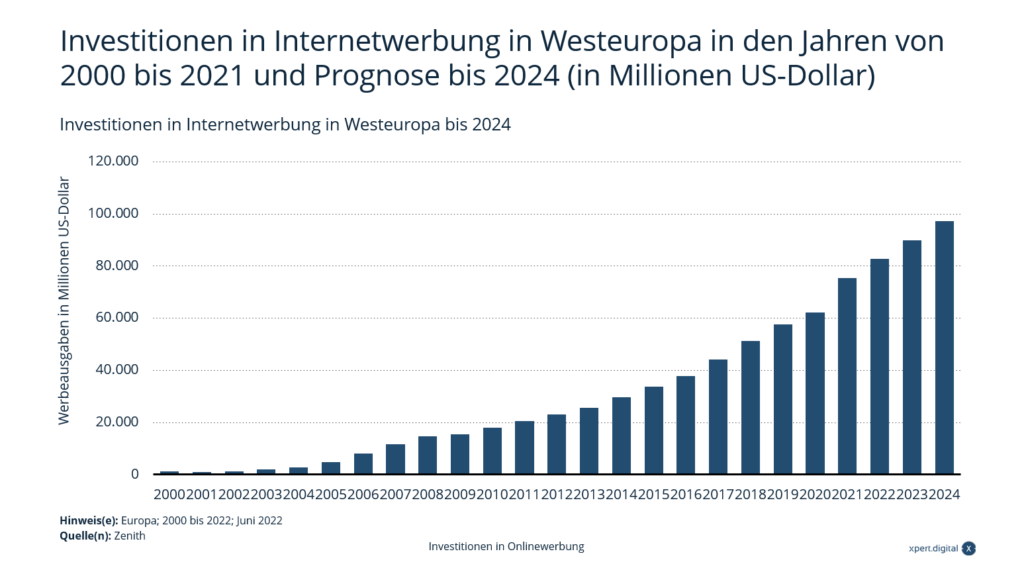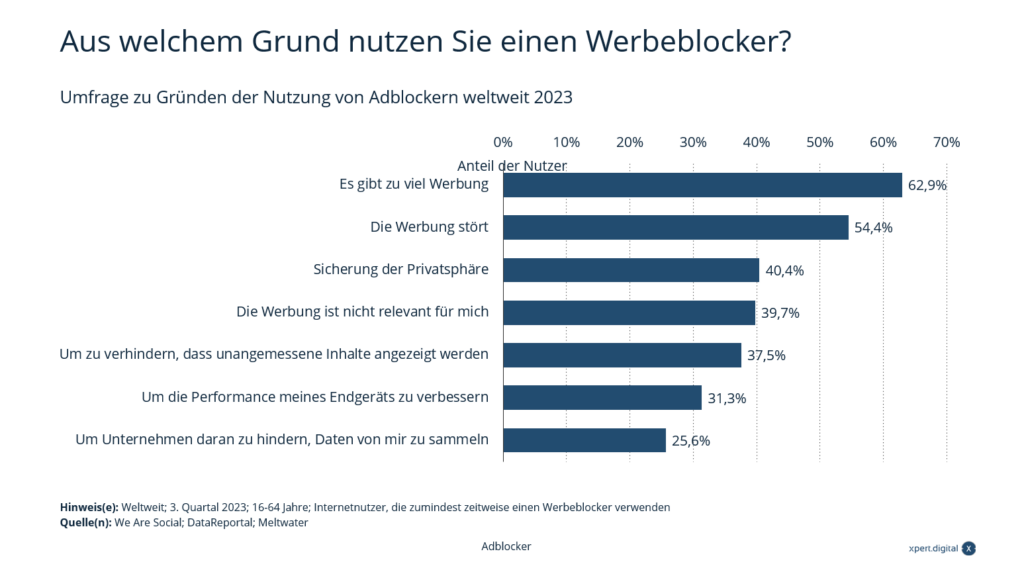Beware of the trap: Digitalization is not a playground - ads, DTC sales and the harsh reality of performance marketing
Language selection 📢
Published on: August 10, 2024 / update from: August 10, 2024 - Author: Konrad Wolfenstein

Beware of the trap: Digitalization is not a playground - Ads, DTC sales and the harsh reality of performance marketing - Image: Xpert.Digital
🎯 Performance marketing in the DTC area: Why it is more difficult than expected
🌐💡 Digitization has turned a lot upside down in the business world. Especially the Direct-to-Consumer (DTC) Sales, which deals with wholesale and retail and enables direct contact with the customer, seems to be a lucrative strategy at first glance. But reality shows that it is far from as easy as it sounds. High investment costs, intensive competitive pressure and challenges in performance marketing provide companies with considerable problems.
✨🎯 The supposed shine of the DTC sales
DTC sales promise great advantages: by selling directly over the Internet, the middlemen can be bypassed and costs can be saved. It also enables a closer relationship with the customer and offers the opportunity to collect valuable data about purchasing behavior. But this ideal is often difficult to achieve in reality.
🚧🔍 challenges and hurdles
First of all, not all products are suitable for DTC sales. Products that require intensive advice or prefer traditional approaches are difficult to market over this channel. But there are also many challenges for suitable products: building up your own e-commerce infrastructure requires high initial investments. The platform not only has to be user -friendly, but also work reliably - failures can quickly ruin a company's reputation.
💰🔄 High investment effort and price competition
Another important point is the immense cost. The structure and maintenance of a DTC strategy are expensive. From the platform to marketing to logistics - every area requires investments. In addition, the competition in the online area often competes with the price. As a result, discount campaigns and price reductions become the norm, which in turn reduces the profit margins.
💔🚶♂️ Falling customer loyalty
A big problem is falling customer loyalty. An almost endless selection of products and providers are available to customers on the Internet. Comparisons are made quickly, and a cheaper offer is often just a click away. This means that customers are less loyal and that companies have to fight for consumers' favor.
📊⚖️ Performance marketing: blessing or curse?
Performance marketing is an indispensable part of the DTC sales. Measures such as social ads, Google Ads and influencer marketing should help to steer traffic onto the website and thus increase sales. But there are also great challenges here.
💵💻 The high costs of performance marketing
First of all, the cost of performance marketing is considerable. The prices for advertising on social networks and search engines have risen sharply in recent years. This can quickly become a financial burden for small and medium -sized companies. In addition, the success of such campaigns is often difficult to measure. Despite high expenses, the desired success often fails to materialize, which leads to frustration and uncertainties.
🌟🔍 The dark side of influencer marketing
Influencer marketing was a long time as a miracle weapon in digital marketing. The personal relationship and trust that influencers enjoy with their followers can lead to impressive results. But here, too, reality is often different: Many companies report that the hoped -for successes fail. A one -time collaboration with an influencer is usually not enough to create sustainable customer loyalty. In addition, the cost of influencer cooperations has risen sharply in recent years. Many influencers require high fees, which questions the profitability of such campaigns.
🔄🎨 Addiction risk and creative restrictions
Another problem of performance marketing and influencer marketing is the risk of falling into a kind of addiction. Companies are increasingly relying on data -driven decisions and often forgot the creative component. Brand formation and long -term strategies often fall victim to the short -term goals. This can lead to the brand losing identity and interchangeable.
🚀 scenarios and motivations despite the challenges
Why do companies continue to rely on DTC sales despite these challenges? There are different scenarios and motivations that explain this trend:
👀🛍️ Visibility and brand presence
One reason why companies choose DTC sales is the increase in visibility. A strong online presence can better perceive brands. This can be an opportunity, especially for new and smaller companies, to establish themselves on the market and to find a niche.
💸🔖 Losser strategy
Another scenario is the "Loss Leader" strategy. Certain products are offered at particularly low prices to lure customers to the website. The aim is to attract customers with attractive offers and to make them buy other, higher -priced products. However, this strategy can be risky because it presses the margins and there is a risk that customers only perceive the cheap offers and do not make any further purchases.
🏆📉 Competition pressure
The strong competitive pressure literally forces many companies into DTC sales. Especially in highly competitive markets, there is often no choice but to rely on this sales channel. Companies have the feeling that they have to keep up so as not to fall behind.
🔄🔗 The reality of customer loyalty
Despite all these scenarios, customer loyalty in practice often remains low. Customers are extremely price -sensitive and willing to change on the Internet. An attractive offer of the competitor can quickly lead to the hard -developed customer base melts. This presents companies with the challenge of constantly being innovative and competitive.

Investments in internet advertising in Western Europe from 2000 to 2021 and forecast by 2024 (in millions of US dollars)-Image: Xpert.Digital
🛒 Direct-to-consumer (DTC) Sales: Opportunities and challenges in practice
The Direct-to-Consumer (DTC) Sales, i.e. the direct sale of products from the manufacturer to the end customer, by circumventing wholesale and retail, is the ultimate dream for many entrepreneurs. This model, which is mainly about the Internet, promises significant cost reductions and personnel savings as well as maximizing profits. This dream should become a reality, especially by the use of performance marketing and influencer cooperations. But reality often looks different than you imagine in theory.
📈 attractive visions of the DTC sales
In theory, DTC sales have clear advantages:
1. Cost reduction
The direct sale does not apply to the margin, which otherwise goes to wholesale and retail.
2. Personnel savings
A leaner operating sequence saves personnel and operating costs.
3. Direct customer contact
Direct contact with the customer enables direct feedback and closer customer loyalty.
🔄 Flywheel model in influencer marketing: attract, interact, inspire
In the digital age, performance marketing plays a central role in implementing this strategy. Performance marketing includes measures such as social ads, social selling, Google Ads, retargeting/remarketing, display-ads and more. An essential part of this strategy is influencer marketing, in which social media influencer present products of your numerous followers and thus work according to the Flywheel model: attract, interact, inspire and complete for purchase.
❗ The challenges of DTC sales
Despite these advantages, many entrepreneurs face considerable challenges if they put on DTC:
1. Not all products are suitable
Not every product can be sold profitably directly to the end customer. Advice and a physical point of sale still require particularly explanatory or very special products.
2. High investment effort
The establishment of a strong online presence and the implementation of extensive marketing campaigns requires considerable financial means.
3. Competition lever price
DTC providers often have to compete with the price, which can lead to falling margins.
4. Customer loyalty
Customer loyalty is difficult if the main attractiveness of the offer is the low price.
5. Discount campaigns as essentials of performance marketing
Discounts and special actions that are often part of the standard in performance marketing can reduce the perceived value of a brand in the long term.
6. Removing consumer reactions
Customers are increasingly responding less to traditional online marketing methods due to flooding through advertising.
7. Brand formation and creativity suffer
While the design and packaging of the products stand out, it can happen that their actual quality and uniqueness take a back seat.
In this context, performance marketing can look like an addiction from which it is difficult to find a way out.
💸 cost factor performance marketing
Although performance marketing offers a clear overview of costs and click data, there is a risk that the numbers will be consciously or unconsciously glossed out. The advertising campaigns not only cause costs for the creation, administration and support, but also considerable ads. In addition, there are expenses for external agencies that specialize in different channels and whose integration is necessary, since internal marketing managers often cannot manage this complexity alone. The costs for influencer marketing can also be significant, which forces many companies to fight hard to fight for profitability.
In order to conceal the apparently endless costs, some companies use accounting tricks: costs are distributed to different accounts in order to make the return on investment (ROI) look better.
📊 three main scenarios despite high costs:
1. Expansion of visibility
Increasing level of awareness and increasing the market shares in order to establish themselves in the long term.
2. “Loss Leader” concept
Previous losses are compensated for by future profits. This is done by collecting contact information from first buyers and then specifically addressing these customers by email marketing to promote recurring purchases.
3. Competitive pressure
Especially in highly competitive markets such as fashion, cosmetics and nutritional supplements, there is often no other way to accept high marketing costs in order to stay in business.
Nevertheless, customer loyalty remains almost zero in these scenarios. It is a misconception that long -term customer loyalty would be automatically secured by performance marketing.
🤔 Interesting observations and reality
While platforms such as Google and Meta continuously record record income and proudly display their luxurious lifestyles, the financial success of most advertisers remains modest. It is strikingly quiet when it comes to concrete success stories. This shows the discrepancy between the theoretical promises of the DTC model and the hard reality in which there are many companies.
🔍 Careful cost-benefit analysis and continuous adjustments!
The direct-to-consumer sales undoubtedly offer exciting opportunities and significant advantages, especially with regard to cost reduction and direct customer contact. However, these advantages also face significant challenges that entrepreneurs should not underestimate. High marketing costs, strong competition and often deceptive customer loyalty are just a few of the hurdles that need to be mastered.
Entrepreneurs should therefore carry out careful cost-benefit analysis and continuously adapt their strategies to the changing market conditions in order not to get into the trap of endless performance marketing. Ultimately, only a holistic and flexible approach can secure long-term success in DTC sales.
➡️ It is therefore all the more important not only to develop performance marketing expertise, but also to integrate them into the established and existing business models in order to create real added value.
➡️ are market experts with specialized performance marketing expertise, not just general market or performance expertise.
⚾⚽🏉 Sales & Marketing Learnings: About the addiction to performance marketing – when “Nike” lost its lead with inefficient online advertising

Sales & Marketing Learnings: About the addiction to performance marketing – when “Nike” lost its lead with inefficient online advertising – Image: Xpert.Digital
The case of Nike impressively illustrates how a former sports icon can maneuver itself into the sidelines through a failed marketing strategy. For decades, Nike built its image through gigantic sponsorship deals and unforgettable advertising campaigns. These measures not only shaped the perception of the brand, but also created a strong emotional bond between the brand and its consumers.
By pivoting to digital direct sales and performance marketing in 2020, Nike sought to adapt to changing market conditions, particularly during lockdowns. At first, the move seemed effective as online sales increased and inventory began to move. But this strategy had serious long-term disadvantages.
More about it here:
📱🚀🔍 Xpert.Digital - PDF collection: Focus on digital marketing and AI
Focus on digital marketing and AI
- Marketing worldwide
- Dialogue marketing in Germany – includes, among other things, email marketing
- B2C influencer marketing
- search engines
- Online Advertising
🎯 The topic of performance marketing and the challenge of the ad blockers
👁️ speed refusal: Why users love adBlocker and how marketers can react
The topic of performance marketing is omnipresent in today's digital world. Companies invest billions in online advertising to place their products and services directly with the target group. But what happens if this target group begins to actively defend itself against this advertising? A significant proportion of internet users uses so -called ad blockers to avoid ubiquitous advertising. This development represents a significant challenge for performance marketing. In this text I will shed light on the reasons why users use AdBlocker and what the performance marketing can learn from it.
🚀 Why do people use ad blockers?
A look at the reasons why people use AdBlocker shows a clear picture: the users are overwhelmed by the amount and type of advertising. The most common reason for the use of an ad blocker is the sheer mass of advertising that users find excessively. In the modern, networked world, it is not uncommon for a single user to see dozens of advertisements within a few minutes. This flood of advertising is perceived by many as annoying, which leads to a negative attitude towards online advertising in general.
Another reason that is often called is the disorder that causes advertising. Advertising often interrupts the natural flow of internet use and can significantly impair the consumption of content. Whether they are pop-ups that take the entire screen or videos that are played automatically-such interruptions lead to frustration and ultimately to decide to install AdBlocker.
In addition to the pure amount and the annoying nature of advertising, data protection also plays an important role. Many users are concerned about how their data is collected and used by advertisers. The use of ad blockers offers these users a feeling of security and control over their online experience.
Another interesting motive for the use of ad blockers is the relevance of the advertising. Many users feel bothered by advertising that is not relevant to them. This "misplaced" advertising is often perceived as useless and annoying. When users repeatedly see irrelevant advertising, they lose confidence in the brand and interest in the products or services offered.
🌐 What can the performance marketing learn from it?
The findings for the use of ad blockers offer valuable lessons for performance marketing. The first and perhaps most important point is that the user experience must come first. If advertising is perceived as annoying, it harms more than it benefits. It is not enough to simply switch as many advertisements as possible; It is crucial to design these ads in such a way that they do not bother or interrupt the user.
1. less is more
One of the clearest messages that AdBlocker users send is that there is too much advertising. Advertisers should consider how they can tighten their campaigns to switch less, but more effective ads. Quality should be over quantity. Targeted and personalized advertising can be less invasive and still achieve high commitment rates.
2. Increase relevance of the advertising
In order to gain the trust of the users, advertisers must ensure that their ads are relevant. This requires deeper segmentation and a better focus on the target group. Advertisers must effectively use the data they collect through their users to create advertisements that meet the interests and needs of these users.
3. Transparency in dealing with data
Data protection concerns are another important reason for the use of ad blockers. Companies should be transparent through their data acquisition practices and give users more control over how their data is used. This can be achieved through clear data protection guidelines that are easy to understand and options for users to restrict the scope of data use.
4. Priorize user experience (UX)
Advertising should not affect the user experience. Pop-ups, automatic video advertising and other intrusive formats are the main cause of frustration. It is therefore important to design advertising in such a way that it fits seamlessly into the use of use. Native advertising, in which advertising appears as part of the editorial content, can be a solution here if it is implemented correctly.
5. Build long -term customer relationships
Instead of striving for short -term success through aggressive advertising, companies should aim to build long -term relationships with their customers. This can be done through valuable content, useful information and well thought -out interactions. Such a strategy can strengthen the trust of customers and make them voluntarily deal with the brand instead of feeling bothered by advertising.
🔮 The future of performance marketing in an ad blocker-friendly world
Performance marketing is faced with the challenge of adapting to a world in which more and more users are using AdBlocker. This requires a fundamental revision of the strategies that are currently being used. Companies have to become more creative and find ways to transmit their messages in a way that appeals to the users without annoying them.
A possible solution could be in the development of new advertising formats that are less invasive and appealing. Interactive advertising that includes the user could play a role here. The integration of advertising into the content itself, without being recognizable as such, could also be a strategy to increase the effectiveness of advertising and at the same time reduce the use of AdBlockers.
Another important aspect is the further training and sensitization of advertisers. Many of them are not fully aware of the negative effects of excessive and intrusive advertising. Workshops, seminars and training could help to raise awareness of these topics and to direct the advertising industry in one direction that meets both the interests of the advertisers and the user.
Performance marketing can learn valuable lessons for the use of ad blockers. By focusing on the user experience, increasing the relevance of advertising, introducing transparent data protection practices and developing innovative advertising formats, it can assert itself in a world in which users want to take increasing control over their online experience. The challenge is to design advertising in such a way that it is not perceived as a load, but as added value. This is the only way to successful performance marketing in the future.
📣 Similar topics
- 📣 Use AdBlocker: What does performance marketing learn?
- 🛡️ Privacy and advertising: Find a balance
- 💼 Optimize user experience: less is more
- 🔍 Relevance of the advertising: tailored to the target group
- 👥 Build trust: through transparent data use
- 📊 Effectively advertise: user -centered approaches
- 🔒 Data protection: A fundamental topic in marketing
- 📱 Interactive advertising: Include and win users
- 🎯 Better address target groups: bypass the ad blocker
- 🖥️ Innovative advertising formats: future of marketing
#️⃣ hashtags: #user experience #datenschutz #relevant advertising #betransportz #innovative advertising
Our recommendation: 🌍 Limitless reach 🔗 Networked 🌐 Multilingual 💪 Strong sales: 💡 Authentic with strategy 🚀 Innovation meets 🧠 Intuition
At a time when a company's digital presence determines its success, the challenge is how to make this presence authentic, individual and far-reaching. Xpert.Digital offers an innovative solution that positions itself as an intersection between an industry hub, a blog and a brand ambassador. It combines the advantages of communication and sales channels in a single platform and enables publication in 18 different languages. The cooperation with partner portals and the possibility of publishing articles on Google News and a press distribution list with around 8,000 journalists and readers maximize the reach and visibility of the content. This represents an essential factor in external sales & marketing (SMarketing).
More about it here:
📌 Other suitable topics
We are there for you - advice - planning - implementation - project management
☑️ SME support in strategy, consulting, planning and implementation
☑️ Creation or realignment of the digital strategy and digitalization
☑️ Expansion and optimization of international sales processes
☑️ Global & Digital B2B trading platforms
☑️ Pioneer Business Development
I would be happy to serve as your personal advisor.
You can contact me by filling out the contact form below or simply call me on +49 89 89 674 804 (Munich) .
I'm looking forward to our joint project.
Xpert.Digital - Konrad Wolfenstein
Xpert.Digital is a hub for industry with a focus on digitalization, mechanical engineering, logistics/intralogistics and photovoltaics.
With our 360° business development solution, we support well-known companies from new business to after sales.
Market intelligence, smarketing, marketing automation, content development, PR, mail campaigns, personalized social media and lead nurturing are part of our digital tools.
You can find out more at: www.xpert.digital - www.xpert.solar - www.xpert.plus



































